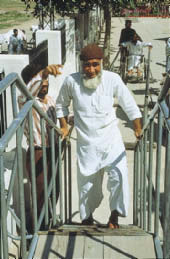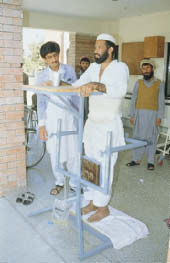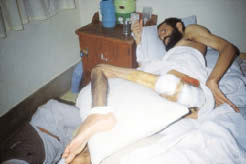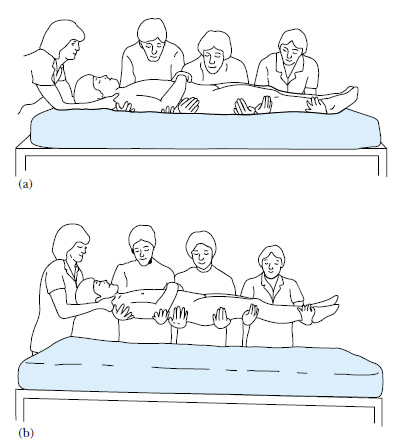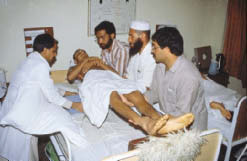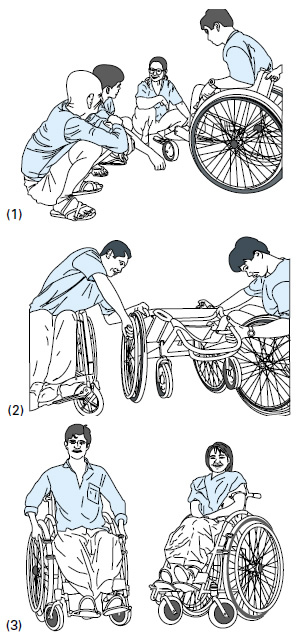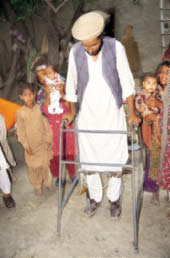Spinal cord injury in the developing world
Introduction
The situation in the developing world is characterised by a high incidence of spinal cord injuries and poor financial resources, which, in addition, may be unevenly distributed within countries and districts. Other health priorities make it difficult for decision makers to allocate significant means for spinal cord injury care and management. Staff are very often inadequately trained and have to work in a difficult environment with little financial reward. They often have to struggle in order to survive as individuals. Discharge planning can be difficult with lack of social help, poor housing conditions, and architectural and social barriers. Given all these challenges, how can we effectively care and provide for spinal cord injured patients in the Third World?
The challenges:
- Poor financial resources
- Other health priorities make it difficult to allocate significant means for spinal cord injury care
- Inadequately trained and poorly paid staff
- Inadequate social help
- Poor housing conditions
- Architectural and social barriers
Incidence of spinal cord injury
The incidence of spinal cord injury is higher than in the western world. Factors that contribute to this include:
- poor road conditions
- poor servicing of vehicles
- high speed and unsafe driving
- lack of seat belts or headrests in cars
- corruption and bribery interfering with the implementation of traffic regulations
- overcrowded cars, shifting the centre of gravity of the cars
- abuse of alcohol and narcotic drugs
- widespread use of firearms in certain cultures
- inadequate safety measures when diving, playing contact sports, or repairing roofs
- unusual circumstances such as falling from a cart, from trees or accidents involving animals such as collisions with camels crossing the road
It is, however, difficult to know the size of the problem given that proper epidemiological studies are lacking in most countries except the United States, where data has been relatively well collected. If the incidence can only be estimated in countries like France and the United Kingdom, it is no wonder that precise data is unavailable for developing countries. Rightly so, international funding agencies are not prepared to spend scarce resources in trying to obtain the exact figures when stress has to be laid on providing treatment.
There have been attempts in a few countries to portray a clearer picture of the situation. The available epidemiological studies have quoted the incidence for Russia, Romania, Turkey and Taiwan as 29.7, 30, 12.7 and 18.8 per million respectively. The incidence can vary within the same country as has been highlighted in a recent study on Turkey, and within different age groups. Thus in Taiwan with an annual incidence of 18.8 per million people, the incidence is 47.6 per million for the geriatric population.
These figures relate to the survival rate of those who sustain a spinal cord injury. An epidemiological study carried out in Portugal quotes the annual incidence as 57.8 new cases per million inhabitants, including those who died before being admitted to hospital, with an annual survival rate of 25.4 new cases per million inhabitants. The death rate was very high during the first week, peaking during the first 24 hours. One would expect a higher global incidence of death for developing countries.
Incidence:
- Epidemiological studies generally lacking
- Higher incidence than in western world
- Mostly paraplegic
- Predominantly young males
The causes of spinal cord injury vary from one country to another. Motor vehicle accidents accounted for 49% of spinal cord injuries in Nigeria, 48.8% in Turkey and 30% in the geriatric population in Taiwan. Falls from heights represented another major source of spinal cord injury with 36.5% in Turkey and 21.2% in Jordan. In Bangladesh the most common causes of traumatic lesions were falls while carrying a heavy weight on the head and road traffic accidents. Other causes included gunshot wounds (between 1.9% and 29.3% in Turkey), stab wounds (between 1.38% and 3.33% in Turkey, 25.8% in Jordan), and diving accidents.
In general 60% of patients were paraplegic and 40% tetraplegic. The mean age at injury was 30 years in Nigeria, 35.5 and 15.1 years in Turkey, 33 years in Jordan, and 10–14 years in Bangladesh. The male to female ratio was 10 : 1 in Nigeria, 1.7 : 1 in Taiwan, and 5.8 : 1 in Jordan. This points to a predominantly young male population being affected. They often are the "breadwinners" and the already precarious financial situation of the family can be further compromised by the sudden disappearance of the main source of revenue and subsistence.
Financial considerations
The situation is characterised by 80% of the world population having access to only 20% of the world’s financial resources. There are big demands on these resources. Health has to compete with other areas and within health there are so many other priorities, so that rehabilitation needs are not easily met.
The mid-1998 world population stood at 5901 million inhabitants with 4719 million (80%) living in less developed regions. Asia accounted for 61% (3585 million), Africa for 749 million, and Latin America and the Caribbean 504 million. These figures will be increased as projected in Table Population (X106) of the major regions of the world. Source: UN Population Division: World Population Prospectus. The 1998 Revision:
| Regions | 1998 | 2050 |
| World | 5901 | 8909 |
| More developed regions | 1182 | 1155 |
| Less developed regions | 4719 | 7754 |
| Africa | 749 | 1766 |
| Asia | 3585 | 5268 |
| Europe | 729 | 628 |
| Latin America/Caribbean | 504 | 809 |
| Northern America | 305 | 392 |
| Oceania | 30 | 46 |
A more detailed analysis shows that eight out of the ten countries having more than 100 million inhabitants are from the less developed regions. They include China (1256 million), India (982 million), Indonesia, Brazil, Pakistan, Russian Federation, Bangladesh, and Nigeria. The United States and Japan also have more than 100 million inhabitants. These countries allocate resources to the health of their citizens, according to their means and priorities, as in Table Health expenditure per capita for selected countries. Source: World Health Report 2000, World Health Organisation, Geneva:
These figures point to the gross inequality between countries, which is further compounded by the inequality within each country. Furthermore it is estimated that of the world’s 6 billion people, 2.8 billion live on less than 2US$ per day and 1.2 billion on less than 1US$ per day. Financial resources are therefore very scarce and priorities focus on maternal and child health, investing in a strong primary healthcare system, HIV and AIDS, clean water, and sanitation. It is doubtful whether substantial resources will ever be made available for spinal cord injury care. The only way to ensure that a reasonable standard of care is offered world wide is to be innovative in devising a strategy that will require as little financial means as possible.
| Country | Health expenditure per capita in US dollars per year |
| United States of America | 4187 |
| Switzerland | 3564 |
| Germany | 2713 |
| France | 2369 |
| United Kingdom | 1303 |
| Brazil | 319 |
| Russian Federation | 158 |
| Nigeria | 30 |
| Indonesia | 18 |
| Pakistan | 17 |
| Bangladesh | 13 |
| Somalia | 11 |
Manpower and staffing issues
Rehabilitation medicine is often not as highly regarded as other specialities such as orthopaedic surgery. It may therefore be easier to find orthopaedic surgeons able to fix the spine, whether or not it is indicated, rather than spinal cord injury specialists. In many instances, surgery is isolated from rehabilitation, which might never be offered to the patient. Management of bladder, bowel and sexual function can be poorly organised, and skin care overlooked, leading to pressure sores. Patients can develop complications and die of chest or urinary infection or untreated autonomic dysfunction.
Nurses will be attracted to areas that are less physically demanding and labour intensive in countries where the use of hoists is not widespread and manual handling of patients is necessary. Physiotherapists are not always adequately trained, and can sometimes be physical training instructors who have only had a few months’ training in the fundamentals of anatomy, physiology, and movement. Occupational therapy does not exist as a speciality in many countries. Social workers have little to offer in terms of state help. The other difficulties relate to a very low level of salaries, lack of equipment, and medication. This in turn may lead to demotivation and reinforce individualistic attitudes, whereas the focus should have been on teamwork.
Social, psychological and architectural barriers
Among the major obstacles to successful rehabilitation of spinal cord injury are social issues and the way society views disability. The social barriers include limited financial means available within the community, and the household not allowing survival with dignity; changing social roles when a "breadwinner" loses his job, physical independence and status within the family; stress on the family who have to find new human and other resources to look after the disabled; struggle with the physical environment within and around the house. In addition, wheelchairs may not be available, or are too expensive.
The way society views disability is a reflection of social and religious values. In certain cultures, disability is viewed as a punishment for past sins. In others, disabled people may not be allowed to enter certain religious sites if they are incontinent of urine or faeces and considered "unclean or soiled". Religious considerations may be so important that — for patients not to be excluded from their environment — they dictate how the paralysed bladder and/or bowel will be managed.
Prejudice is widespread against the disabled person, who is pitied. By acquiring a spinal cord injury, a person becomes part of a group he or she was previously looking down upon. Disabled people are at times hidden from mainstream life and cared for in a separate environment within the family dwelling. It is not common to see a disabled person going out shopping, to the cinema, or participating in active life. Little has been done to empower the individual or give him or her a voice. The tendency has been for charitable organisations to provide institutional help and care, thus appeasing social conscience, but not promoting dignity, individual expression, and choice. Some societies take pride in promoting the view that their system is acceptable, with the extended family taking up an active new, supportive role, but many problems exist "behind closed doors".
Substantial financial resources are not expected to become available; they may even become scarcer. Social and religious values are deep-rooted and might not be easy to change, and it would be unrealistic to believe that we can do much about changing the physical environment to bring it to the level of developed societies with wide pavements, roads, streets, slopes, doors, and rooms all wheelchair friendly.
Providing for the needs of spinal cord injured patients in developing countries
Any rehabilitation programme for spinal cord injured patients needs to address the issues highlighted above. We suggest a national strategy to look at and address the global picture, and local initiatives and implementation for increased efficiency and ownership. The international community has a duty and responsibility to provide help, expertise and support.
When planning the strategy, care must be taken not to blindly apply the methodology used in the developed world, but to adapt the principles of treatment to take into account the specificity of the Third World, especially the limited financial means and cultural differences. Much of what has been addressed in this book will be applicable to Third World countries: relevant topics will include clinical and neurological assessment; principles of management by nurses, physiotherapists and occupational therapists; bladder and bowel management; home adaptations. However, there will be no powered turning beds, and little or no physiotherapy and occupational therapy equipment. Handling of patients will be manual as in Figure above. Surgical expertise and equipment as well as medication may be lacking. In some countries, enthusiasm to create sophisticated, well-equipped rehabilitation centres may be misplaced. It is essential to be innovative and use the principles of low-cost technology and self-reliance (principally on local, including human, resources). These principles have been successfully applied in two Red Cross projects: manufacturing wheelchairs, orthopaedic devices and therapy equipment using pipes, bicycle wheels and other local materials; using conservative management as often as possible to treat spinal fractures, particularly as surgery is so much more expensive and at times unnecessary; investing in training of staff and relatives/carers.
A comprehensive programme will focus on the following areas:
- Prevention of spinal injuries, using all available media and modes of communication.
- Education of the general public on suspecting spinal injuries at the sites of accidents, together with the development of means to improve handling, lifting and transportation of patients.
- Designation of a few hospitals to be the referral centres for the specialised treatment of spinal injuries.
- Training of staff within the hospitals and the community both in individual, professional skills and to work within a multidisciplinary team.
- Provision of the required specialist tools, using the principles of low-cost technology and self-reliance.
- Involvement of carers and relatives in managing patients in hospital, and training them in areas such as turning, positioning of patients, chest physiotherapy, and bladder and bowel evacuation.
- Setting up appliance services to manufacture at low cost: wheelchairs, orthoses such as cervical and thoracolumbar braces, and drop-foot devices.
- Offering psychological and social support to patients to deal with acute problems and those anticipated at their discharge. Incorporating psychological interventions to help individuals cope with their disability, and the community (key family members and religious or spiritual leaders) to be more aware of disability issues. Thus there could be a shift towards more empowerment of the disabled so that they can have a greater say in their destiny instead of being "assisted".
- Identification of discharge problems: architectural barriers within the house/flat and community, and means of overcoming them using all resources available nationally and locally.
- Organising access to medical help within the local community, and long-term follow-up of discharged patients.
- The international community with support from international organisations (World Health Organisation, United Nations, World Bank, Non-Governmental Organisations) will help in providing exchanges of ideas, experience, technical know-how, especially in the areas of appropriate technology, and training of hospital and community staff. Of relevance will be the organisation of regional seminars, and the publication of teaching
Comprehensive programme:
- Prevention of spinal injuries
- Education of general public
- Training of staff, carers, and relatives
- Use of principles of low-cost technology (using local materials when possible) and self-reliance
- Being innovative in overcoming discharge barriers
Conclusions
It would be fair to acknowledge the hard work of a few individuals and non-governmental organisations in many parts of the world. Their contributions have undoubtedly impacted positively on the lives of a significant number of people with spinal cord injury. The world needs to learn from their experience. It is essential to devise a strategy that will allow access to care for spinal cord injury patients worldwide, bearing in mind the limited financial means and the social, psychological, architectural barriers that will not change significantly in years to come.
See also
- At the accident:
- History and epidemiology of spinal cord injury
- Spinal injuries management at the scene of the accident
- Evacuation and initial management at hospital:
- Evacuation and transfer to hospital of patients with spinal cord injuries
- Initial management of patients with spinal cord injuries at the receiving hospital
- Neurological assessment of patients with spinal cord injuries
- Spinal shock after severe spinal cord injury
- Partial spinal cord injury syndromes
- Radiological investigations:
- Initial radiography of patients with spinal cord injuries
- Cervical injuries
- Thoracic and lumbar injuries
- Early management and complications of spinal cord injuries — I:
- Respiratory complications
- Cardiovascular complications
- Prophylaxis against thromboembolism
- Initial bladder management
- The gastrointestinal tract
- Use of steroids and antibiotics
- The skin and pressure areas
- Care of the joints and limbs
- Later analgesia
- Trauma re-evaluation
- Early management and complications of spinal cord injuries — II:
- The anatomy of spinal cord injury
- The spinal injury (cervical, thoracic and lumbar spine)
- Transfer to a spinal injuries unit
- Medical management in the spinal injuries unit:
- The cervical spine injuries
- The cervicothoracic junction injuries
- Thoracic injuries
- Thoracolumbar and lumbar injuries
- Deep vein thrombosis and pulmonary embolism
- Autonomic dysreflexia
- Biochemical disturbances
- Para-articular heterotopic ossification
- Spasticity
- Contractures
- Pressure sores
- Urological management of patients with spinal cord injury:
- Nursing for people with spinal cord lesion:
- Physiotherapy after spinal cord injury:
- Respiratory management
- Mobilisation into a wheelchair
- Rehabilitation
- Recreation
- Incomplete lesions
- Children
- Occupational therapy after spinal cord injury:
- Hand and upper limb management
- Home resettlement
- Activities of daily living
- Communication
- Mobility
- Leisure
- Work
- Social needs of patient and family:
- Transfer of care from hospital to community:
- Education of patients
- Teaching the family and community staff
- Preparation for discharge from hospital
- Easing transfer from hospital to community
- Travel and holidays
- Follow-up
- Later management and complications after spinal cord injury — I:
- Late spinal instability and spinal deformity
- Pathological fractures
- Post-traumatic syringomyelia (syrinx, cystic myelopathy)
- Pain
- Sexual function
- Later management and complications after spinal cord injury — II:
- Later respiratory management of high tetraplegia
- Psychological factors
- The hand in tetraplegia
- Functional electrical stimulation
- Ageing with spinal cord injury
- Prognosis
- Spinal cord injury in the developing world:

